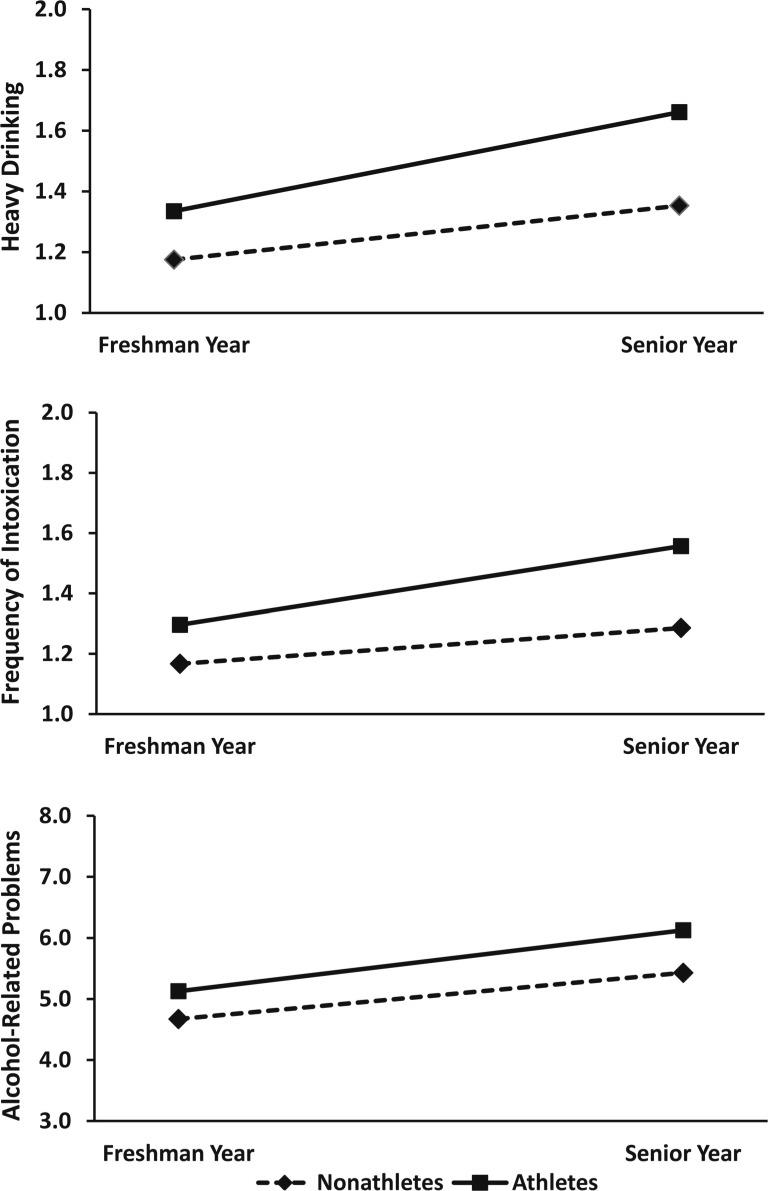Alcohol use, specifically risky drinking, has been a public health concern on college campuses for many years. Previous research has suggested that college athletic involvement is associated with an increased likelihood of alcohol consumption (Leichliter et al, 1998). This week, as part of our Special Series on Addiction and Sports,The DRAM explores ta study that examined the progression of alcohol consumption and alcohol-related problems and how it relates to athletic participation (Cadigan et al., 2013).
Methods
- Researchers utilized data from 1590 college students who participated in a 4-year longitudinal study (the Intensive Multivariate Prospective Alcohol College-Transitions Study [IMPACTS]: Sher and Rutledge, 2007).
- Using data averaged across two semesters per year, researchers examined three risky drinking outcomes:
- Frequency of heavy drinking – How many times in the last 30 days did you consume five or more drinks in a single sitting?
- Frequency of intoxication – How many times in the past 30 days did you get drunk (e.g., speech was slurred or unsteady on your feet) on alcohol?
- Alcohol-related problems – Participants were asked if they had experienced 34 different “alcohol-related problems” in the past year (e.g., “Gotten in trouble at work or school because of drinking”).
- Analyses included comparisons of four groups of students: nonathletes (i.e., no athletic involvement during freshman or senior year), “starters” (i.e., no athletic involvement freshman year, athletic involvement senior year), “stoppers” (i.e., athletic involvement during freshman year, not senior year), and athletes (i.e., athletic involvement during freshman and senior year).
Results
- For all groups, all risky drinking outcomes (frequency of heavy drinking, frequency of intoxication, and the number of alcohol-related problems) significantly increased from freshman year to senior year.
- As the Figure shows, students who participated in college athletics had significantly higher rates of heavy drinking and frequency of intoxication across time and significantly greater increases in heavy drinking and frequency of intoxication from freshman to senior year than nonathletes.
- Overall levels of alcohol-related problems did not differ significantly between these groups, but athletes had significantly greater increases in alcohol-related problems from freshman to senior year than nonathletes.
- Athletes who transitioned into college athletics (starters) had sharper increases in risky drinking outcomes when compared to athletes who transitioned out of athletics (stoppers).
Figure 1: Mean changes in alcohol outcomes for athletes and nonathletes (reproduced with permission from Alcohol Research Documentation, Inc., publisher of the Journal of Studies on Alcohol and Drugs (www.jsad.com))
Limitations
- The sample is based on a large, predominantly white NCAA D1 midwestern public university and therefore the results of this study might not be applicable to universities of different size, geographical location, and athletic conference.
- The researchers used a yearly average that might not accurately represent the drinking habits of college athletes, as previous research has shown that athletes generally exhibit less risky drinking during their competitive season (Martens, 2006).
- Finally, this study did not distinguish between types of sport such as individual competition or team sports, which might have different risky drinking participation.
Conclusion
This research suggests that involvement in college athletics is associated with higher levels of risky drinking. Athletes also experience a sharper increase in risky drinking from freshman year to senior year, particularly consistent athletes and those who start participating in college athletics after their freshman year. Sports-related anxiety and a culture of alcohol or pressure from teammates might contribute to higher rates of risky drinking. As a result, athletes might benefit from specialized education efforts from their athletic departments (e.g. alcohol culture in athletics or how alcohol consumption can affect athletic performance). This will likely be more effective than a generalized alcohol education effort given to all students.
— Layne Keating
What do you think? Please use the comment link below to provide feedback on this article.
References
Cadigan, J. M., Littlefield, A. K., Martens, M. P., & Sher, K. J. (2013). Transitions into and out of intercollegiate athletic involvement and risky drinking. Journal of Studies on Alcohol and Drugs, 74(1), 21–29.
Leichliter, J. S., Meilman, P. W., Presley, C. A., & Cashin, J. R. (1998). Alcohol use and related consequences among students with varying levels of involvement in college athletics. Journal of American College Health: J of ACH, 46(6), 257–262. http://doi.org/10.1080/07448489809596001
Martens, M. P., Dams-O’Connor, K., & Beck, N. C. (2006). A systematic review of college student-athlete drinking: Prevalence rates, sport-related factors, and interventions. Journal of Substance Abuse Treatment, 31(3), 305–316. http://doi.org/10.1016/j.jsat.2006.05.004
Sher, K. J., & Rutledge, P. C. (2007). Heavy drinking across the transition to college. Addictive Behaviors, 32(4), 819–835. http://doi.org/10.1016/j.addbeh.2006.06.024





